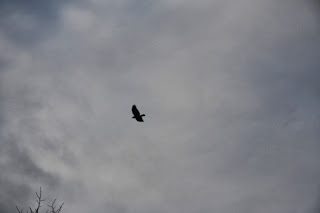This month the "Getting Started Suggestion" over at the Handbook of Nature Study blog was to choose birds as the focus of our nature study for the rest of the term. I jumped at this suggestion, as we had already seen a pileated woodpecker and mallard ducks on the first of the month. It seemed like a promising beginning!


Our second nature walk was in the woods at Victoria Park. We kept a sharp eye out for birds, but all we saw were crows, crows, and more crows.


Can you believe I was disappointed? Crows are so common here, it was almost as though I hadn't even really seen them. I can't remember what made me think again, but eventually I did. I don't know very much about crows at all. I looked them up in my trusty Handbook of Nature Study (page 124), and I learned a few things. I'll share a few with you that I hadn't known before.
- "Both parents are devoted in the care of the young, and remain with them during most of the summer."I think the sentinel must have alerted the flock of crows we saw, because they were wheeling around in the sky above the woods and making an awful racket.
- "Crows gather in flocks for the winter; these flocks number from fifty to several hundred individuals, all having a common roosting place, usually in pine or hemlock forests or among other evergreens."
- "When crows are feeding in the fields there is usually, if not always, a sentinel posted on some high point so that he can give warning of danger." (HoNS, p.125)
We took our third nature walk on the Confederation Trail in Murray River. We heard several different bird calls, including a chickadee, a crow, and a blue jay, but we didn't see a single bird. It may have been because it was raining at the time. Driving along the road afterwards, we suddenly came upon a field of Canada Geese and Ring-billed Gulls!


The Handbook of Nature Study didn't have much about gulls, but my Formac Pocket Guide to Prince Edward Island Birds had several varieties. Besides the Ring-billed Gull, I have also seen Herring Gulls and Great Black-Backed Gulls this week. I don't think I ever noticed before that there are so many varieties of gulls.
My November list of birds so far:
Pileated Woodpecker
Mallard Ducks
Blue Jays
American Crows
Common Ravens
Herring Gulls
Canada Geese
Ring-Billed Gulls
Great Black-Backed Gulls
European Starlings
I haven't had a chance to go out and buy a birdfeeder yet, but I hope to do that within the next couple of weeks. I'm really looking forward to doing more bird studies!
Submitted to the Outdoor Hour Challenge Blog Carnival.

You have had a great start to your bird study. I saw my first Pileated Woodpecker this year and they are so BIG! Thanks for sharing your bird list with the OHC blog carnival.
ReplyDeleteThank you for your welcome.
DeleteThis is a wonderful bird study!
ReplyDeleteI know what you mean by the crows. I still think they are interesting! We saw a Downy woodpecker at Victoria Park this month but I didn't have my camera. I was disappointed because the woodpecker was not bothered by us observing him at all!
The pileated woodpecker was the same. It didn't bother it a bit that people were gathering around and talking. I think it was used to people being in the park...the tree it was on was quite scarred, so I think it had been working on it for a while.
DeleteThank you for your post. The crow thing is what hooked me into HBNS, we see the everyday abundance and seldom give consideration to find a fun mkrsel of information. Glad you shared about crows!
ReplyDeleteThank you for your post. The crow thing is what hooked me into HBNS, we see the everyday abundance and seldom give consideration to find a fun mkrsel of information. Glad you shared about crows!
ReplyDeleteThanks for stopping by. I love the Handbook of Nature Study!
Delete